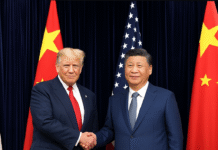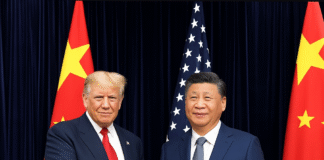
|
Getting your Trinity Audio player ready...
|
The United States and China have resumed high-level trade negotiations in a last-ditch effort to avoid a dramatic escalation in tariffs that could destabilize global markets and reignite economic tensions between the world’s two largest economies.
Talks are currently underway in Stockholm between U.S. Treasury Secretary Scott Bessent and Chinese Vice Premier He Lifeng. The two sides are aiming to secure a 90-day extension of the current trade ceasefire before the looming August 12 deadline. If no agreement is reached, punitive tariffs—some reaching as high as 145% on Chinese exports and 125% on U.S. goods—could automatically snap back into effect.
A Delicate Balancing Act
This latest round of discussions highlights the fragile state of U.S.-China relations, where both nations appear eager to maintain short-term economic stability without resolving deeper, structural disputes. These include Chinese industrial overcapacity, U.S. restrictions on high-tech exports, and disagreements over fentanyl-linked chemical products.
While no breakthroughs have been announced, officials on both sides have signaled cautious optimism. A successful extension could open the door for a potential Trump–Xi summit in October or November, an event that would mark the first in-person meeting between the two leaders since 2023.
Avoiding an Economic Shock
The stakes are high. Global investors fear a collapse in talks could shock markets and undermine fragile economic recovery efforts across Asia, Europe, and the U.S. Already, analysts warn that a return to triple-digit tariffs could disrupt trade flows, raise consumer prices, and strain supply chains just as inflation appears to be stabilizing.

Adding to the pressure is the recent finalization of a new U.S.-EU trade agreement, which introduces a 15% tariff cap on European exports in exchange for $600 billion in U.S. investment pledges. That deal is being viewed as a strategic benchmark for how Washington may structure future trade frameworks—including with Beijing.
Political Calculations at Play
The Biden administration, while emphasizing national security and tech sovereignty, appears to be shifting toward a more pragmatic stance as the 2026 U.S. midterm elections approach. Similarly, Beijing faces internal economic headwinds and is under pressure to shore up investor confidence and avoid further capital flight.
As a temporary goodwill gesture, Washington has reportedly paused enforcement of certain tech export restrictions, including AI chip bans affecting U.S. firms like Nvidia, to keep negotiations on track.
What’s Next?
Negotiations in Stockholm are expected to continue over the coming days. If successful, the 90-day extension would push the tariff deadline to mid-November—offering both governments breathing room to pursue a broader trade settlement.
For now, the world watches closely as the U.S. and China navigate one of their most delicate diplomatic balancing acts in years—one that could define the future of global trade for the rest of the decade.
Danchima Media International News Team
© 2025 All Rights Reserved

